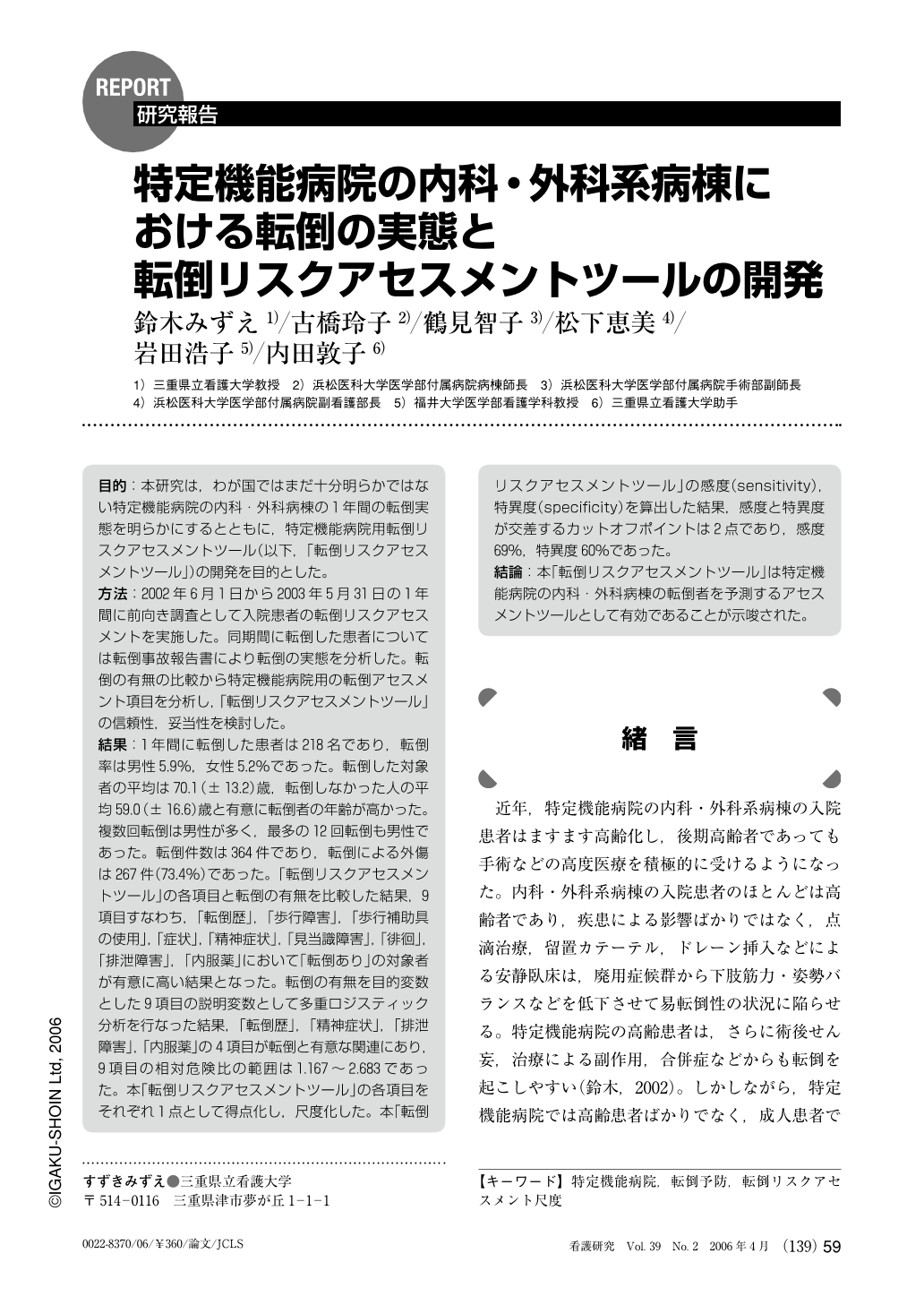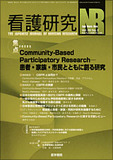Japanese
English
- 有料閲覧
- Abstract 文献概要
- 1ページ目 Look Inside
- 参考文献 Reference
- サイト内被引用 Cited by
目的:本研究は,わが国ではまだ十分明らかではない特定機能病院の内科・外科病棟の1年間の転倒実態を明らかにするとともに,特定機能病院用転倒リスクアセスメントツール(以下,「転倒リスクアセスメントツール」)の開発を目的とした。
方法:2002年6月1日から2003年5月31日の1年間に前向き調査として入院患者の転倒リスクアセスメントを実施した。同期間に転倒した患者については転倒事故報告書により転倒の実態を分析した。転倒の有無の比較から特定機能病院用の転倒アセスメント項目を分析し,「転倒リスクアセスメントツール」の信頼性,妥当性を検討した。
結果:1年間に転倒した患者は218名であり,転倒率は男性5.9%,女性5.2%であった。転倒した対象者の平均は70.1(±13.2)歳,転倒しなかった人の平均59.0(±16.6)歳と有意に転倒者の年齢が高かった。複数回転倒は男性が多く,最多の12回転倒も男性であった。転倒件数は364件であり,転倒による外傷は267件(73.4%)であった。「転倒リスクアセスメントツール」の各項目と転倒の有無を比較した結果,9項目すなわち,「転倒歴」,「歩行障害」,「歩行補助具の使用」,「症状」,「精神症状」,「見当識障害」,「徘徊」,「排泄障害」,「内服薬」において「転倒あり」の対象者が有意に高い結果となった。転倒の有無を目的変数とした9項目の説明変数として多重ロジスティック分析を行なった結果,「転倒歴」,「精神症状」,「排泄障害」,「内服薬」の4項目が転倒と有意な関連にあり,9項目の相対危険比の範囲は1.167~2.683であった。本「転倒リスクアセスメントツール」の各項目をそれぞれ1点として得点化し,尺度化した。本「転倒リスクアセスメントツール」の感度(sensitivity),特異度(specificity)を算出した結果,感度と特異度が交差するカットオフポイントは2点であり,感度69%,特異度60%であった。
結論:本「転倒リスクアセスメントツール」は特定機能病院の内科・外科病棟の転倒者を予測するアセスメントツールとして有効であることが示唆された。
Aim : A prospective study was conducted from June 1, 2002 to May 31, 2003, to investigate the occurrence of accidental falls among inpatients from an acute care university hospital. We also developed and evaluated a fall risk assessment instrument.
Methods : Subjects included 3,912 patients (2,146 males ; 1,766 females) from an acute care university hospital. On the first day of admission to the hospital, nurses evaluated subjects for fall risk using the 9-item assessment instrument.
Results : During the study period, there were 218 subjects who fell ; the fall rate was 5.87% for males and 5.21% for females. There were significant age differences between the subjects who fell[70.1 (±13.2) years old] and those who did not fall[59.0 (±16.6) years old] (p<0.05). There were 364 cases of accidental falls, with a total of 267 (73.35%) injuries that occurred as a result of an accidental fall. Twenty male subjects sustained two or more falls that resulted in 143 (59.89%) incidents of injury. Nine items were significantly associated with falling : Previous fall experience, Gait disorder, Requires assistance with walking, Symptoms of dizziness and feeling dizzy when standing up, Psychotic manifestations, Disorientation, Wandering, Incontinence of bowels, and Taking medication. Multiple logistic regression was conducted to examine independent contribution of risk factors for falls. Four items were significantly related with falling : Previous fall experience, Psychotic manifestations, Incontinence of bowels, and Taking medication. The range of relative risk was 1.11─2.617. As a result, the cutoff point was 2, sensitivity was 0.689, and specificity was 0.595.
Conclusion : Our findings suggest that our assessment instrument was effective in the evaluation of fall prevention for an acute care university hospital.

Copyright © 2006, Igaku-Shoin Ltd. All rights reserved.


